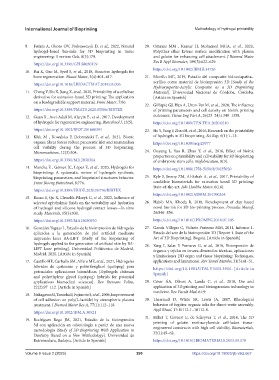Page 298 - IJB-9-2
P. 298
International Journal of Bioprinting Methodology of hydrogel printability
9. Fatimi A, Okoro OV, Podstawczyk D, et al., 2022, Natural 20. Omrani MM , Kumar H, Mohamed MGA, et al., 2020,
hydrogel-based bio-inks for 3D bioprinting in tissue Polyether ether ketone surface modification with plasma
engineering: A review. Gels, 8(3):179. and gelatin for enhancing cell attachment. J Biomed Mater
Res B Appl Biomater, 109(5):622–629.
https://doi.org/10.3390/GELS8030179
https://doi.org/10.1002/JBM.B.34726
10. Bai X, Gao M, Syed S, et al., 2018, Bioactive hydrogels for
bone regeneration. Bioact Mater, 3(4):401–417. 21. Morello MC, 2019, Estudio del composite hidroxiapatita–
https://doi.org/10.1016/J.BIOACTMAT.2018.05.006 acrílico como material de bioimpresión 3D [Study of the
Hydroxyapatite-Acrylic Composite as a 3D Bioprinting
11. Cheng Y, Shi X, Jiang X, et al., 2020, Printability of a cellulose Material]. Universidad Nacional de Córdoba, Córdoba.
derivative for extrusion-based 3D printing: The application [Article in Spanish]
on a biodegradable support material. Front Mater, 7:86.
22. Gillispie GJ, Han A, Uzun-Per M, et al., 2020, The influence
https://doi.org/10.3389/FMATS.2020.00086/BIBTEX of printing parameters and cell density on bioink printing
12. Guan X , Avci-Adali M, Alarçin E , et al., 2017, Development outcomes. Tissue Eng Part A, 26(23–24):1349–1358.
of hydrogels for regenerative engineering. Biotechnol J, 12(5). https://doi.org/10.1089/TEN.TEA.2020.0210
https://doi.org/10.1002/BIOT.201600394 23. He Y, Yang F, Zhao H, et al., 2016, Research on the printability
13. Klak M , Kowalska P, Dobrzański T, et al., 2021, Bionic of hydrogels in 3D bioprinting. Sci Rep, 6(1):1–13.
organs: Shear forces reduce pancreatic islet and mammalian https://doi.org/10.1038/srep29977
cell viability during the process of 3D bioprinting.
Micromachines, 12(3):304. 24. Ouyang L, Yao R, Zhao Y, et al., 2016, Effect of bioink
properties on printability and cell viability for 3D bioplotting
https://doi.org/10.3390/MI12030304 of embryonic stem cells. Biofabrication, 8(3).
14. Mancha E , Gómez JC, López E, et al., 2020, Hydrogels for https://doi.org/10.1088/1758-5090/8/3/035020
bioprinting: A systematic review of hydrogels synthesis,
bioprinting parameters, and bioprinted structures behavior. 25. Kyle S, Jessop ZM, Al-Sabah A, et al., 2017, Printability of
Front Bioeng Biotechnol, 8:776. candidate biomaterials for extrusion based 3D printing:
State-of-the-art. Adv Healthc Mater, 6(16).
https://doi.org/10.3389/FBIOE.2020.00776/BIBTEX
https://doi.org/10.1002/ADHM.201700264
15. Russo E, Qu X, Chwalik-Pilszyk G, et al., 2022, Influence of
selected ophthalmic fluids on the wettability and hydration 26. Habib MA, Khoda B, 2018, Development of clay based
of hydrogel and silicone hydrogel contact lenses—In vitro novel bio-ink for 3D bio-printing process. Procedia Manuf,
study. Materials, 15(3):930. 26:846–856.
https://doi.org/10.3390/MA15030930 https://doi.org/10.1016/J.PROMFG.2018.07.105
16. González Yeguas L, Estudio de la bioimpresión de hidrogeles 27. García Villegas C, Vidarte Pastrana MM, 2011, Informe 1.
aplicados a la generación de piel artificial mediante Estado del arte de la bioimpresión 3D [Report 1. State of the
impresión laser BA-LIFT [Study of the bioprinting of Art of 3D Bioprinting]. Bogotá. [Article in Spanish]
hydrogels applied to the generation of artificial skin by BA- 28. Yang I, Salas F, Pomares G, et al., 2018, Bioimpresión de
LIFT laser printing]. Universidad Politécnica de Madrid, órganos y tejidos en tercera dimensión: técnicas, aplicaciones
Madrid, 2020. [Article in Spanish]
y limitaciones [3D organ and tissue bioprinting: Techniques,
17. Castillo HE, Carballo SM, Alfaro ME, et al., 2021, Hidrogeles applications and limitations]. Rev Tecnol Marcha, 31(3):41–51.
híbridos de quitosano y polietilenglicol (quit:peg) para https://doi.org/10.18845/TM.V31I3.3900. [Article in
potenciales aplicaciones biomédicas [Hydrogels chitosan Spanish]
and polyethylene glycol (quit:peg) hybrids for potential
applications biomedical sciences]. Rev Iberoam Polim, 29. César ÁA, Olivos A, Landa C, et al., 2018, Use and
22(2):97–112. [Article in Spanish] application of 3D printing and bioimpression technology in
medicine. Rev Facult Med, 61:9.
18. Nakagawa M, Teraoka F, Fujimoto S, et al., 2006, Improvement
of cell adhesion on poly(L-lactide) by atmospheric plasma 30. Therriault D, White SR, Lewis JA, 2007, Rheological
treatment. J Biomed Mater Res A, 77(1):112–118. behavior of fugitive organic inks for direct-write assembly.
Appl Rheol, 17:10112-1–10112-8.
https://doi.org/10.1002/JBM.A.30521
31. Billiet T, Gevaert E, de Schryver T, et al., 2014, The 3D
19. Rodríguez Rego JM, 2021, Estudio de la bioimpresión printing of gelatin methacrylamide cell-laden tissue-
3d con aplicación en odontología a partir de una nueva engineered constructs with high cell viability. Biomaterials,
metodología [Study of 3D Bioprinting With Application in 35(1):49–62.
Dentistry Based on a New Methodology]. Universidad de
Extremadura, Badajoz. [Article in Spanish] https://doi.org/10.1016/J.BIOMATERIALS.2013.09.078
Volume 9 Issue 2 (2023) 290 https://doi.org/10.18063/ijb.v9i2.667

